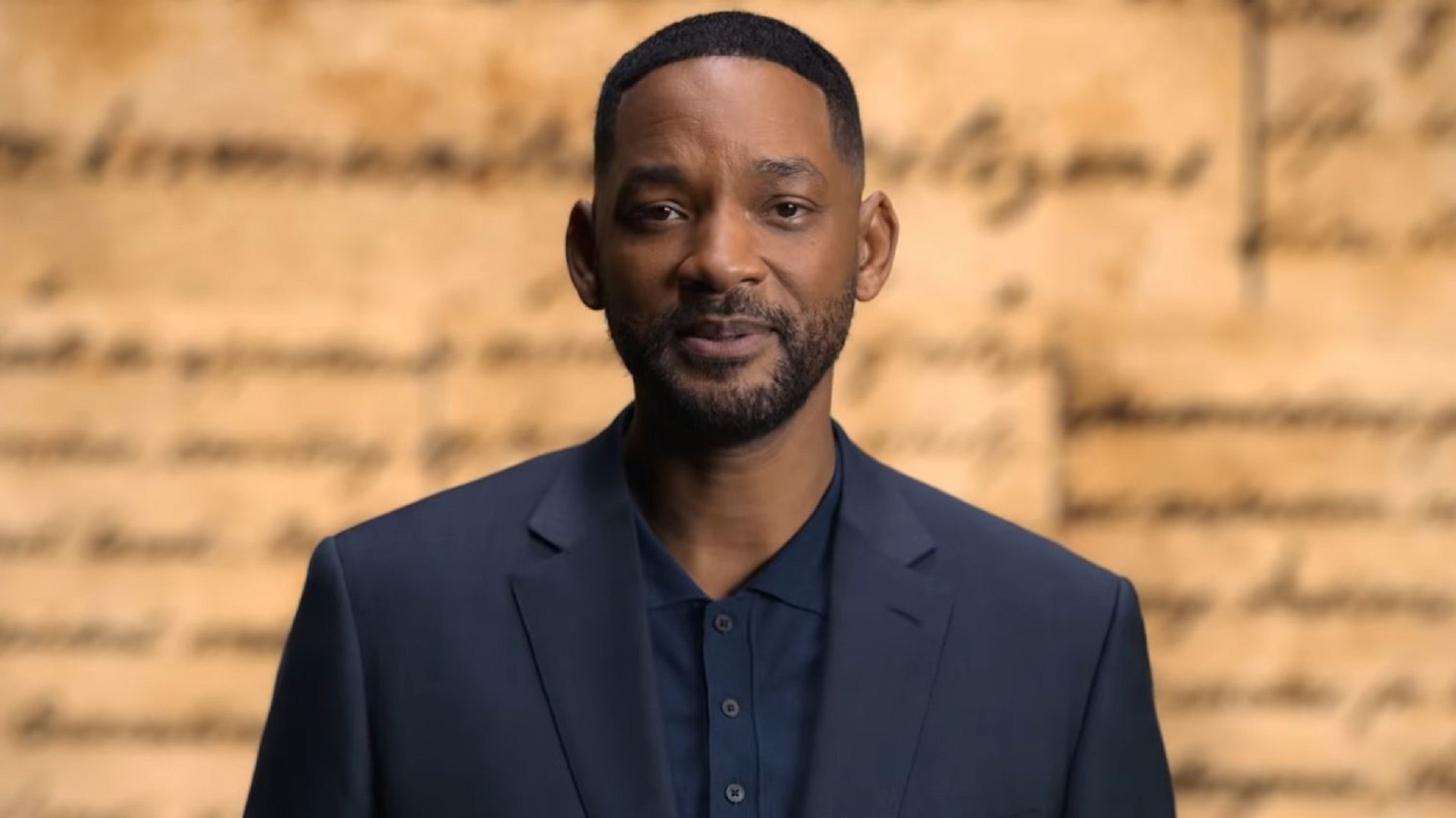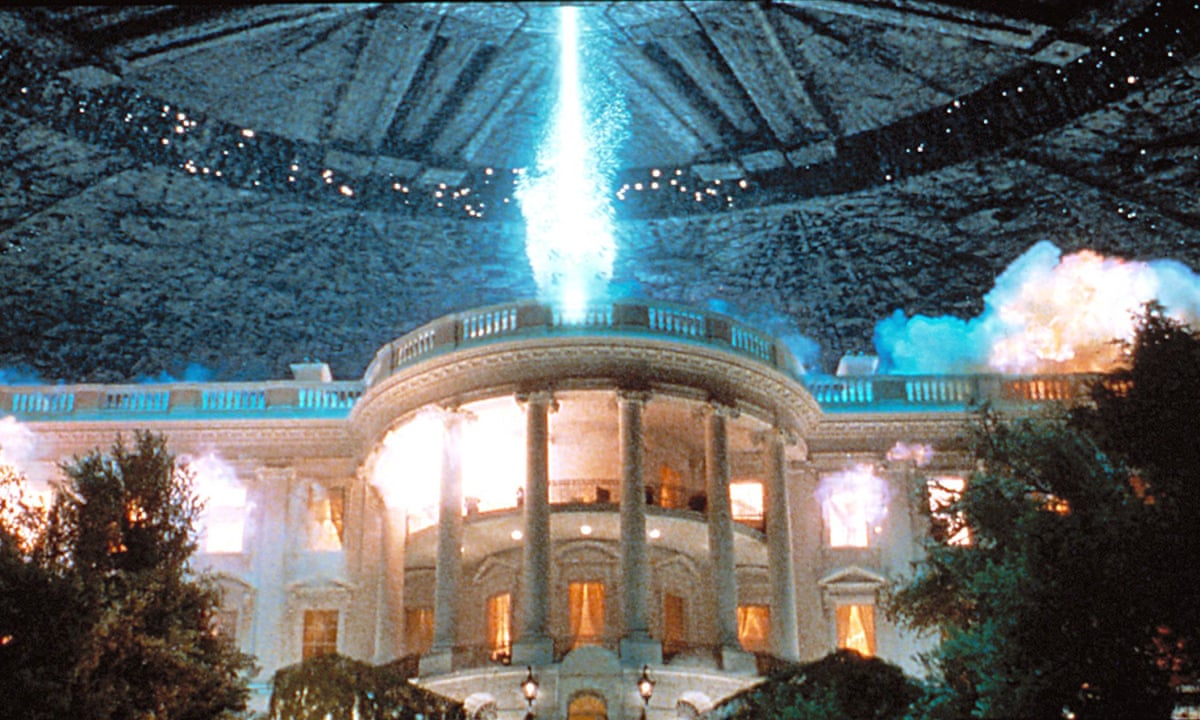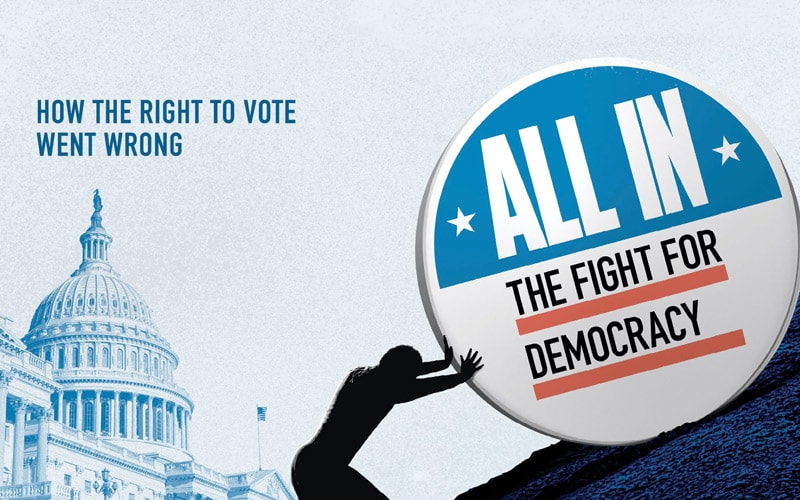Happy Voter Education Week! Each day, you can take a small action to ensure you’re ready to exercise your right to vote! The official website spells out each step very simply and easily!
To celebrate the week, we’ll be commemorating some of America’s biggest milestones in federal voting rights by pairing each with a complementary film… and only some are documentaries. If that sounds thrilling, then you’re my kind of person! If it sounds a bit *whispers: boring,* then don’t worry! The list includes space aliens, a llama, and Paul Giamatti. Who doesn’t love Paul Giamatti?
Milestone: The Constitution (1788)
The Show: Adams (2008)

As promised: Paul Giamatti, who brilliantly plays our second President John Adams (the guy who gets called a fat motherf*#ker in Hamilton) in all his ungraceful, prickly glory. The HBO miniseries begins pre-Declaration with the Boston Massacre and ends with his incredibly poetic (and historically accurate) death: His son is the President. In his old age, he befriends Thomas Jefferson, formerly his bitter political rival. They die the same day, mere hours apart. The year? 1826. The day? Fourth of July.
Throughout the series we see the early political theater that defined a nascent America, specifically the first few presidential elections. Of course, voters at the time were white Anglo-Saxon Protestant men who owned property. Needless to say, voting rights had a long, long way to go.
Oh ya, and we see Ben Franklin in the bathtub with a French woman.
The Milestone: 14th Amendment for Citizenship (1868)
The Show: Will Smith’s Amend – The Fight for America (2021)

This year, Will Smith brought a six-part infotainment masterpiece to Netflix covering one of the most crucial pieces of legislation that isn’t a household name: the 14th amendment. This law granted citizenship to all people “born or naturalized in the United States” with “equal protection under the laws,” making it a crucial complement to the 13th amendment banning slavery.
In the series, the Fresh Prince takes a look at the implications of the amendment throughout history, including some of the most well-known court cases in America: Plessy v Ferguson, Brown v Board of Education, Roe v Wade, and more. He does so with the help of animation, music, and reenactments from the likes of Joseph Gordon-Levitt, Mahershala Ali, Laverne Cox, and more.
Very honorable mention to the Civil Right Act of 1866 which had very similar ambitions… the 14th simply did it more concretely a few years later.
The Milestone: 15th Amendment for Black Suffrage (1870)
The Film: Free State of Jones (2016)

For such a huge legal victory, it’s pretty shocking how little attention this one gets in film and television. The 15th explicitly granted the right to vote to all citizens regardless of “race, color, or previous condition of servitude.” In other words, former slaves can vote. More challenges would come, however, as Southern states subsequently entered the Jim Crow era of discriminatory voting laws: poll taxes, literacy tests, grandfather clauses, and more. Not until 1965 would the federal government take meaningful action, but more on that later…
Free State of Jones chronicles the tale of Newton Knight (Matthew McConaughey), a disillusioned Confederate soldier who leads a slave revolt in Jones County, Mississippi. A bit white savior-y? Yes, but it’s a story worth telling nonetheless, especially if you keep in mind how anomalous a white southerner fighting for abolition was.
The film features one of the few scenes I could find explicitly addressing the 15th amendment.
The Milestone: 19th Amendment for Women’s Suffrage (1920)
The Film: Iron Jawed Angels (2004)

As a fan of both Horror as well as history, I was disgusted and impressed that this scene took such an unflinching look at what these women’s suffragists were subjected to in prison.
Fearless leaders such as Alice Paul and Lucy Burns, main characters of the film, fought for womens’ right to vote. They were pejoratively described as “nagging iron-jawed angels.” When they were arrested for protesting and initiated hunger strikes, metal devices were shoved in their mouths to facilitate force feeding. “Iron-Jawed” then took on a double meaning. The 19th amendment would be passed a year after the events of the film, banning discrimination “on account of sex.” Of course, mostly Southern states would still restrict minority women from voting, an issue that wouldn’t be really addressed until 1965.
Hip hop legend and activist Yasiin Bey aka Mos Def once voluntarily subjected himself to the same force feeding used in Guantanamo Bay. He offers a disturbing, real-life glimpse at the practice.
The Milestone: Indian Citizenship Act (1924)
The Show: Reservation Dogs (2021)

A modern heist comedy following a few thieving teens living on an Oklahoma Native American reservation. It was shot entirely in Muscogee Nation and written, directed, and showran by Indigenous artists.
It’s a modern tale from a perspective we so rarely see: Reservation youth. Less than a hundred years ago, however, this same community was not considered as citizens. Initially, Native tribes were only sometimes offered citizenship. If they were friendly to the US government, or if they were only part Native, they would be considered. Some women married into citizenship. It wasn’t until 1924 did all Native peoples get citizenship from the federal government.
Extra points to Reservation Dogs for the Tarantino reference.
The Milestone: Chinese Exclusion Act Ends (1943)
The Film: PBS’s The Chinese Exclusion Act (2018)

I feel like I’m cheating by finding a documentary explicitly covering this milestone, but it was difficult to find this exclusion act on film. If you know of any, let me know!
The Chinese Exclusion Act was the first major restriction on immigration in the United States. A lack of work opportunities were blamed on Chinese Americans despite them taking up a fraction of a percentage of the country’s population at the time. So, they were banned and refused citizenship. People v Hall ruled that Asians could not testify in court and any hopes of justice were dashed. It wasn’t until 1943, when China allied with the United States in World War II, did the act get repealed. Finally, Chinese immigrants could become citizens, as could their families who were born in America. And with citizenship– the vote.
Honorable mention to PBS’s “Asian Americans” docu-series.
The Milestone: 23rd Amendment for DC Residents Presidential Voting Rights (1961)
The Film: Independence Day (1996)

Independence Day, the action sci fi romp, is an America-tastic tale of explosions and fighting aliens. Not fighting immigrants, but literal space aliens, a nice change of pace. The film is a humanist fantasy of a pseudo-political flavor, a picture of humanity coming together regardless of color or creed (yet it still takes place on America’s independence day, of course). A bit too close to an All Lives Matter messaging? Perhaps, but that just further cements this action staple as the definition of ‘Murica, the movie.
The fact that the very American movie takes place largely in Washington, DC highlights the irony that is the 23rd amendment: since 1800 and until 1961, those situated at the country’s headquarters could not vote for President. Because DC is the capital and not a state, it took special provisions to allow its residents to vote in Presidential and Vice Presidential elections as well as have electoral college representation.
It’s a serious issue, but if someone wants to make a quirky political comedy about the 23rd, give me a ring.
The Milestone: 24th Amendment Banning Poll Taxes (1964)
The Film: Willie Velasquez – Your Vote is Your Voice (2016)

This PBS documentary chronicles the work of Willie Velasquez, Presidential Medal of Freedom recipient and founder of the Southwest Voter Registration Education project which helped enfranchise Latino / Hispanic voters for decades.
The Velasquez story gets started right around the time when poll taxes, a practice that prohibited the poor from voting, were banned by the 24th amendment.
The Milestone: Voting Rights Act of 1965
The Film: Selma (2014)

The Civil Rights era is already well cemented in the public consciousness, as is Martin Luther King Jr and his march on Selma. This film, depicting said struggle, offers an accessible experience for those interested in familiarizing themselves with Bloody Sunday or civil rights in general. MLK’s nonviolent approach famously led to success. What success was that? The Voting Rights Act, passed the same year as the fabled march.
The Voting Rights Act remains one of American history’s most crucial and impactful pieces of legislation. It prohibited racial discrimination in voting and explicitly banned literacy tests and similar practices. A number of special provisions and subsequent amendments empowered the federal government to enforce the law and fought for multilingual ballot access. It represents a huge win for the civil rights cause and remains one of the widest-reaching pieces of civil rights law. And as of late, it’s been under attack. But more on that later.
Very honorable mention to the Civil Rights Act of 1964 which was similarly monumental and helped dismantle Jim Crow segregation and discrimination.
The Milestone: 26th Amendment for Youth Voting Rights (1971)
The Film: Napoleon Dynamite (2004)
Voting age used to be 21. Then we sent 18 year olds to fight in Vietnam and the public realized if we were letting them hold a gun overseas, we should probably let them vote.
What better film to celebrate youth voting than Napoleon Dynamite, the story of Pedro who is asking you to vote for him. And it’s got a llama!
Honorable mention to Night of the Living Dead (1968), a horror film largely influenced by the televised horrors of the Vietnam War as well as an early example of a Black hero on film.
The Milestone: Help America Vote Act (2002), Motor Voter Act (1993), and Accessibility Act (1984)
The Film: Recount (2008)

A series of meaningful accessibility laws have been passed in the modern era, offering consideration and greater enfranchisement especially for elederly and disabled voters.
The Help America Vote Act, enacted by President Bush in 2002, allowed for updated voting technology and followed the infamous election dispute between Bush and Gore.
This 2008 film recounts the Presidential vote recount in Florida that controversially led to Bush’s election and highlights the procedural nightmare involved.
The Non-Milestone: Shelby County v Holder (2013), Voter Suppression On The Rise
The Film: All In – The Fight for Democracy (2020)

All In: The Fight for Democracy is a documentary exploring modern incarnations of voter suppression. It prominently features Stacey Abrams as she recounts her own campaign’s struggles with voter suppression when she ran for governor in Georgia.
In fact, a wave of state and local level legislation has been hitting America and making it harder for minority communities to vote. That’s largely thanks to the 2013 Supreme Court case Shelvy County v Holder which largely gutted the Voting Rights Act by removing the need for historically discriminatory states to get new election laws federally checked.
Dishonorable mention to 2013’s other infamous case Brnovich v Democratic National Convention which further removed powers from the Voting Right Act which no longer regulates ballot collecting and out-of-precinct voting…
Which is why it’s so important to secure your right to vote as well as the rights of those around you. I urge you to check out Voter Education Week’s website and follow their steps which make it easier than ever to have your voice heard.

